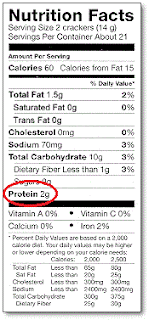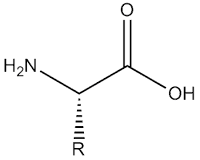
If you've ever looked at the nutritional label on the side of your cereal box (you know, after you've read the front and back several times), you will seen a section titled "Protein." Protein is obviously important for our health, but what exactly is a protein?
Proteins are biological macromolecules (macro because they're huge, containing thousands, sometimes tens of thousands of atoms all bonded together). They belong to a class of macromolecules called polymers. A polymer is built out of a chain of repeating subunits; in the case of proteins, the subunit is an amino acid, shown below.

|
| An Amino Acid |
All amino acids found in living organisms have this same structure. The "R" in the molecule is variable - the identity of the R group defines the amino acid. Using cellular machinery called ribosomes (which are themselves composed partially of proteins), cells build proteins by linking one amino acid at a time into a long chain, which are often modeled as if they were a chain of beads on a string:

|
| "Random Coil" of an unfolded protein |

|
| Stereo image of the structure of the folded protein Human Pin1. If you cross your eyes (like with a Magic Eye poster), until the images overlap, you will eventually see the structure in 3D |
So what do proteins do? A better question is what don't they do. Some proteins provide structure (your hair and fingernails are composed primarily of rigid proteins); some are used as inter-cellular signaling molecules (insulin is released by the pancreas to tell your cells to uptake sugar from the bloodstream). The majority of proteins are enzymes, which carry out virtually every chemical reaction that happens in your body. Anything that happens in a cell is mediated, in some way, by proteins.
So what happens when you eat protein? Well, your body makes all of its proteins itself from amino acids, but it's easier for the body to use pre-made amino acids than to make them itself. Furthermore, there are 9 amino acids, called essential amino acids, which the human body isn't able to make on its own. So when you eat, well, anything, your body takes the proteins in the food you eat, breaks them down to their component amino acids, and then ships those amino acids where they're needed to make the proteins that your body needs.
Notes
Notes
[1] To get a sense for how awesome this is, imagine buying a LEGO castle. You take it home, open the box, and get the pieces out. Then you take the pieces, put them all in a garbage bag, shake them up for a minute and pull out your fully built LEGO castle. The pieces fit together in such a way that the lowest-energy way for them to line up was in the fully-formed castle! It sounds ridiculous, but proteins are such fine-tuned machines that they actually work like that.
